

Repurposing Technology, Making Art. David A. Mellis. Paper Sensors. The idea, here, was to recreate some basic MEMS sensors using paper & conductive ink.
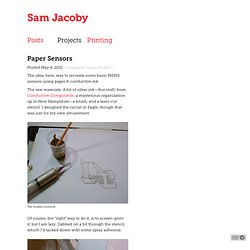
The raw materials. A bit of silver ink—this stuff, from Conductive Compounds, a mysterious organization up in New Hampshire—a brush, and a laser-cut stencil. I designed the circuit in Eagle, though that was just for my own amusement. Of course, the “right” way to do it, is to screen-print it, but I am lazy. Dabbed on a bit through the stencil, which I’d tacked down with some spray adhesive. Strain Gauge This design is based on the work of the George Whitesides Lab, who have done a lot of fine work in paper electronics. The black stripe is carbon-based ink, which has a far higher resistivity than the silver stuff, and changes resistivity dramatically when flexed. George M. Whitesides. George M.

Whitesides (born August 3, 1939) is an American chemist and professor of chemistry at Harvard University. He is best known for his work in the areas of NMR spectroscopy, organometallic chemistry, molecular self-assembly, soft lithography,[2] microfabrication, microfluidics, and nanotechnology. Whitesides is also known for publishing his "outline system" for writing scientific papers.[3] As of December 2011[update], he has the highest Hirsch index rating of all living chemists.[4] Education and academic career[edit] Education[edit] Whitesides attended secondary school at Phillips Andover and graduated in 1957.
Research at MIT[edit] Whitesides began his independent career as an assistant professor at the Massachusetts Institute of Technology in 1963 and remained there until 1982. Pigments. New Textiles 2011. paper-based electronics for creative expression. DIY smart materials.
People. EL Experimenter's Kit - ELEN 4193. The new EL experimenter's kit is now available!

This kit contains all hard to find materials that you need to make your own screen-printed electroluminescent display. This kit is intended for advanced hobbyists and comes with no warranties or guarantees. The kit includes: One vial of DuPont Luxprint phosphor inkOne vial of DuPont Luxprint dielectric inkOne vial of DuPont Luxprint silver inkThree indium tin oxide (ITO) coated glass substratesOne surplus EL power supply (See attached schematic) The kit does not include: Screens for screen printingA hot plateWire, copper tape, electrical tape, etc These kits are being sold as an outreach project by an overworked graduate student.
Kits are currently out of stock. Tutorials / Using a transistor to control high current loads with an Arduino. In this tutorial, you'll learn how to control a high-current DC load such as a DC motor or an incandescent light from a microcontroller.

"ohm" lo-fi cardboard sampler. “Ohm” is a series of electronic lo-fi noiseboxes/recorders made with laser cut grey cardboard. the interface and the inner circuits are printed with a special conductive paint. by touching the printed surface the user can modify the sound in different ways.
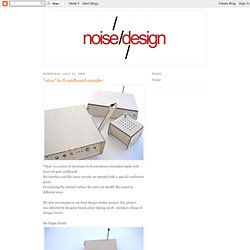
My new noisemaker is my final design studies project. this project was directed by designer barak asher during 2008 , shenkar college of design, Israel. the happy family watch the video's more at youtube: the small the "chop" some more picturestaken by the photographer sasha flit. HOW TO GET WHAT YOU WANT. Welcome to the KOBAKANT DIY Wearable Technology Documentation Workshops least likely scenario This workshop is part of a course at the Ernst Busch Hochschule in Berlin.
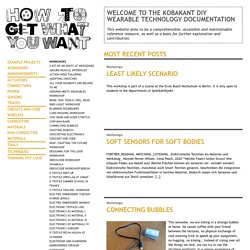
It is only open to students in the departments of Spiel&&Objekt.
Materials, Tools and Techniques for Handcrafting Electronics. Materials, Tools and Techniques for Handcrafting Electronics Saturday 26th March 2011, 11-6pm This workshop is open to anybody interested in learning more about the Kit-of-No-Parts approach to building electronics. - location: High-Low Tech research group, MIT Media Lab, Cambridge/MA - no prior experience with craft or electronics necessary - no fee, materials and tools provided - max. 10 participants, email me to reserve a spot: plusea@mit.edu Description.
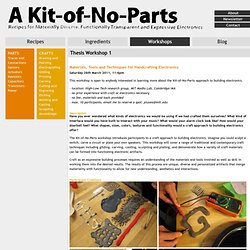
HOW TO GET WHAT YOU WANT. Thermochromic inks are pigments that change color to colorless at certain temperature.
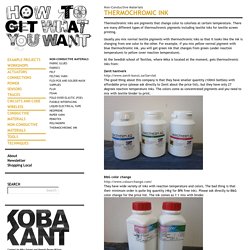
There are many different types of thermochromic pigments including textile inks for textile screen printing. Usually you mix normal textile pigments with thermochromic inks so that it looks like the ink is changing from one color to the other. For example, if you mix yellow normal pigment with blue thermochromic ink, you will get green ink that changes from green (under reaction temperature) to yellow (over reaction temperature). At the Swedish school of Textiles, where Mika is located at the moment, gets thermochromic inks from: Zenit The good thing about this company is that they have smaller quantity (100ml bottles) with affordable price (please ask directly to Zenit about the price list), but they have only 27 degrees reaction temperature inks. Etching 101. Use Vaseline as a resist and a bath of salt and vinegar to etch away the copper from copper fabric to make circuits and sensors.

Inspired by instructions from Rehmi Post and Kit Waal. Also see Sew-through Soft Circuits post by Meredith Scheff on The Steampunk Workshop: >> Step-by-step Tested mix: *100ml vinegar *7ml salt Insert piece of copper fabric. In the above examples the resisting medium (Vaseline) was only applied to one side of the fabric.